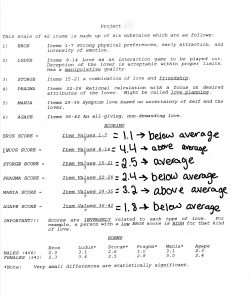ATA 5:
For assignment five, we were instructed to do five nice deeds over the course of a week for either random people or people we know. I decided to do a nice deed Monday through Friday. The five nice deeds I did were sending money to my best friend to get a coffee, holding the door open for a stranger, checking up on an old friend, giving money to a homeless person, and complimenting a stranger. We did the nice things and then wrote about the other person’s reaction as well as how it made us feel. We also wrote about whether or not we thought doing a nice deed for someone each day should be permanently enacted into daily life.
This assignment reminds me of the module 11 archive. In the archive we discussed how the majority of traits grouped together are “happy” and “unselfish”. I feel like happy people are more likely to be unselfish because they are happy with their lives and want to make others happy as well instead of bringing them down. With that being said, I think unhappy people would be happier if they enacted the rule to do a nice deed for someone each day. This assignment felt personally relevant to me because of how it made me feel after doing nice things for people. For example, when I sent my best friend money for a coffee when she was going through a hard time, it felt good to know I could make her day a little better.
Representative Visual Image: Pay It Forward
I chose this image because one of the nice deeds I did was giving money to a homeless person. I see this person often when I go grocery shopping so it felt good to do something nice for them.

http://www.delightatwork.com/delight-at-work/a-good-deed-can-go-a-long-way
ATA 4:
Assignment four was called Styles of Love and it required us to take a love style questionnaire that tested our rankings in eros, ludus, storge, pragma, mania, and agape. We had to discuss whether or not our results were surprising to us and if we found them to be accurate. I found my scores to be very accurate for me currently. I am in a happy, healthy relationship so I felt that my scores were reflecting that. I discussed in my paper how my scores would have been different if I was to take this questionnaire when I was in high school and in a toxic relationship. I mentioned in my paper that I would have related more to the Ludus love style in high school because it was based on manipulation and there was a lot of that in previous relationships. I definitely think a person’s score on this questionnaire can change depending on what is going on in their life at the time.
The topic of love styles reminds me of the topic of our blog this week; emotional intelligence and self-regulation. Emotional intelligence can play a huge role in people’s relationships because it affects the way people handle issues and communicate with each other. I feel like these topics go hand in hand because love styles can often have to do with how you handle your emotions. The assignment was personally relevant to me because I am all about self-reflection. Anytime I can take a quiz such as the love style one, I will take the opportunity to reflect on myself and whether or not I agree with the results. For example, I thought about how accurate each score was for each love style and this made me reflect on my relationship and past relationships.
Representative Visual Image: Love Style Results
I chose this picture as my visual image because it is a summary of my love style results as well as a short description of what each love style is. This gives a good background of what love styles I am talking about in my assignment for someone who has not heard of them.

ATA 2:
In assignment two, we were instructed to choose six pictures that represent who we are. I chose pictures that represented who I am as a girlfriend, as a friend, and as a cat mama. I also chose pictures that represented periods in my life. While writing assignment two and thinking about which pictures I should choose, I learned a lot about self-concept, self-presentation, and self-regulation. I was able to think a lot about how I perceive myself in different areas of my life. It’s not that these were new things I was learning, but rather a reflection of myself. I was able to think about who I am as a girlfriend, a friend, and a daughter. I thought about who I am as a student and how hard I work to achieve my goals. Writing this assignment definitely helped me notice my positive self-concept and self-perception. It also helped me notice how I control my self-presentation and how I often present myself as being happy and positive all the time on social media.
Assignment two reminded me of the final paper I wrote for my introduction to psychology class that I took through dual enrollment in high school. For the final paper, we had to pick several different concepts that we went over in class and relate them to specific people or events in our lives. This was similar to assignment two because we were applying concepts from the course to ourselves and thinking about our self portraits. The difference in the two assignments is that for assignment two we used images of ourselves to discuss the concepts from class and in my final paper we just used storytelling.
This assignment was personally relevant to me because I was reflecting on myself and images that I chose to represent important things in my life. While I was explaining concepts from the course, I was also explaining personal experiences and how they have developed my self-concept. I have been doing a lot of self-reflecting lately regarding my schoolwork and my plans for the future, so this assignment was extra relevant to me since self-reflection is something I have been practicing every day.
Representative Visual Image: My Sixth Picture
I chose this image because it was the sixth picture I chose to write about in my assignment. It was the most recent picture taken that I chose and represented how I sometimes falsely portray my self-presentation on social media. I post pictures of myself that make me look completely happy and worry-free, when in reality, I have my regular anxiety and day to day worries.

ATA 1:
Assignment 1 focused on the four heuristics and examples of each. The heuristics we wrote about were representativeness, availability, anchoring and adjustment, and status quo heuristic. We were asked to come up with original examples for each heuristic. We also had to explain why the use of heuristics can lead to incorrect inferences about people and things. From this assignment, I learned what heuristics are and how frequently they are used by all people. I never knew that these techniques or thinking processes were called heuristics, or the breakdown of each type, but after reading about them I immediately could think of instances and examples from my life. It was interesting to think about how many examples of each heuristic happen all around us everyday.
I can relate the topic of assignment 1 to content I have learned in my Human Cognition psychology class. In Human Cognition, we recently learned about Gestalts Laws of Perceptual Organization, which includes the Law of Similarity. This law applies to when similar things appear to be grouped together. Grouping of similarity can occur because of color, shape, size, and orientation. This Law of Similarity reminds me of the representativeness heuristic. The representativeness heuristic is when you make a judgement based on how much a person or thing may remind you of another person or thing. For this heuristic, people compare one thing to another that they think is similar. It is like the Law of Similarity because they both are dependent on someone’s perception of things and the way someone finds things to be alike.
The assignment was personally relevant to me because I was able to think of real life examples for the heuristics. One that is especially relevant would be the example I used for availability heuristic. I talked about the Covid-19 pandemic and how the craziness of the pandemic has covered up the mental health crisis going on all over the world. The majority of what we hear about on the news and from the media is about Covid-19 and deaths increasing from the virus. This makes it easier for people to not notice the increasing amount of deaths from suicide and mental health issues. In some countries, the suicide rate has surpassed the Covid-19 death rate. I thought this was extremely relevant since it is something we are all currently living through.
Representative Visual Image:
I chose this image because it really relates to the example I used for availability heuristic. When people think about what is going on in the world and what we are all struggling with, it is easy to immediately think of Covid-19. Covid-19 is a more recent topic in the news. It is frequently talked about and we are shown extreme cases. The negativity of it is vivid to us all. This is why we often forget about the mental health crisis.